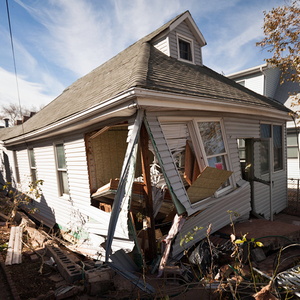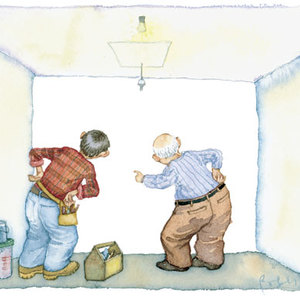
Last night, I began reading American Barns and Covered Bridges by Eric Sloane. In the author’s note, he talks about the unique qualities of early American architecture, particularly northeastern American architecture, about how it’s a response to both the climate and the available materials. I think Sloane gets a lot of the history wrong and makes a bunch of dubious cultural assumptions, but those errors don’t detract from what he gets right about the buildings themselves, many of which have withstood two centuries of New England weather.
Writing in the 1950s, Sloane talks about how farmers of the time also had to be carpenters. Now, I’ve worked on a lot of farmer-built or modified structures, and in my experience very few farmers can carpent worth a damn. What farmer actually has the time, in any event? Consequently, I have my doubts about 18th century farmers having built the barns we associate with them today. I’m pretty sure that actual carpenters built the barns that still stand.
Nonetheless, whoever built those old New England barns understood some basics about durability.
Materials matter
In the barn project I’m working on, nearly every framing member is chestnut. It was the dominant hardwood in the northeast until the chestnut blight showed up a century ago. That’s hard to believe today, when nearly the only chestnut trees to be found in the New England forest are occasional shoots springing from ancient roots. The shoots grow to 15 feet or 20 feet in height before the chestnut blight finds and kills them back to the roots. I have one outside my back door, and I’ve encountered a grove like that while mountain biking, but I’ve never seen a fully grown tree.
Chestnut is strong, relatively light, easy to work,…
Weekly Newsletter
Get building science and energy efficiency advice, plus special offers, in your inbox.

This article is only available to GBA Prime Members
Sign up for a free trial and get instant access to this article as well as GBA’s complete library of premium articles and construction details.
Start Free TrialAlready a member? Log in















12 Comments
Andy, This is a great piece.
I know here in NH, folks often attribute the longevity of old barns to "well they were made with oLd GrOwTh lumber". It is refreshing to hear that, in fact, the longevity is due to proper detailing and smart building (and some maintenance).
When modern builders know the truth (that the details matter) they can learn from history and ensure that their buildings last centuries as well.
I was just discussing with a colleague yesterday whether or not species of wood could be a reliable indicator for longevity. Obviously certain species are more rot resistant (nominally and by traditional wisdom, if not by scientific rigor) but I've questioned how monumental the difference really is between species and whether those differences aren't mostly overridden by design, site-conditions, application, and intra-species variability. I'd love to see an extensive case-study on this. (perhaps someone knows of good studies done?)
The bit about riven red-oak was interesting.
>"Angling or curving that cut greatly reduced the tendency of the joists to crack back from the bottom of the tenon when there was 20 tons of hay stacked on them."
I've heard this referred to as a 'dap.'
The book is Understanding wood By Bruce Hoadley also In the world of boat building and Repair. wood species quickly shows you what will last
also The Richard Jagels ?? has written expensively in Woodenboat magazine about these details
Yes, that is a great book and I am definitely aware of the reasons certain species are favored to last as cited in that book (extractives- which notably only exist in heartwood). As far as I remember, that book doesn't document real world case-studies of wood lasting/rotting according to species.
I've simply become skeptical that species matters to a significant degree given (perhaps) things like the fast growth of most available wood today. I wonder if the playing field has been leveled?
I don't have a lot to base this on other than observing some inconsistencies and hearing incongruous stories from others. All things equal, I'm sure it matters. How much is the question.
Boat building would be a great place to look. I've not lived long enough or been in the right places with the right people to feel confident in relying on species so much as surrounding conditions. (note that many wood sidings actually 'wear' before they rot).
Yes, great piece. Who can't appreciate the skill and effort that went into building old barns? They are the iconic structures of northeast farms and landscapes.
Rick: Don't knock the use of old growth lumber. Andy didn't say this didn't make any difference - he said that good detailing was also important, and obviously, it is. But while old-growth eastern white pine "wasn't too bad, new fast-growth eastern white pine certainly is. Even properly treated and detailed, new pine will predictably fail in 5-10 years in exposed locations.
The paint used is also interesting. It was a milk paint mixed with lime and iron oxide. As far as I know, no one in the US uses it for siding anymore though.
I have all of Sloanes books, he has many things wrong, including uses of various tools
Russell, I have most of his books and he definitely has some interesting ideas but I can't think of any examples of improper tool use, except I think he might have promoted the idea of using an adze to make hand-hewn timbers, when it was usually a broadaxe. Then again, I think I learned about broadaxes with offset handles (for hewing timbers) from his books. Do you have any examples? Not be argumentative, just that I'm a fan and find some of his quirky ideas fun to think about.
Great article. When I was in Africa (Rwanda) I visited the local woodworkers. They still do things much like our ancestors did, including sawing lumber with a long two man rip saw. The local wood is eucalyptus (which is not native to the region and I guess is now invasive), and very hard wood. The sawyers would set up a platform on a steep hillside and saw right there. The work was intense and I doubt most trained athletes today could keep up. I hope the attached photo comes through.
Nick,
Thanks for the interesting report! Great photo.
Reminds me of the very similar photos of loggers in our local museum here on Vancouver Island. The back breaking work involved! Makes me tired just looking at it.
Nick-
Great photo. Somewhere I read (maybe Sloan) about hand sawing like the guys in your photo except instead of being on a hillside they would dig big hole or pit to lay the timbers across. The guy down in the pit was called the “Pitman”. Later as things became mechanized the guy in the pit was replaced by a mechanical arm which became know as a “Pitman arm”. Today you can find a Pitman arms as part of many cars and trucks steering linkage, though of course it has nothing to do with sawing or a guy in a pit.
If you like Sloan here are a few other books you might like
A Building History of Northern New England
Homebuilding and Woodworking in Colonial America
Two Carpenters: Architecture and Building in Early New England.
- Jud
Log in or become a member to post a comment.
Sign up Log in